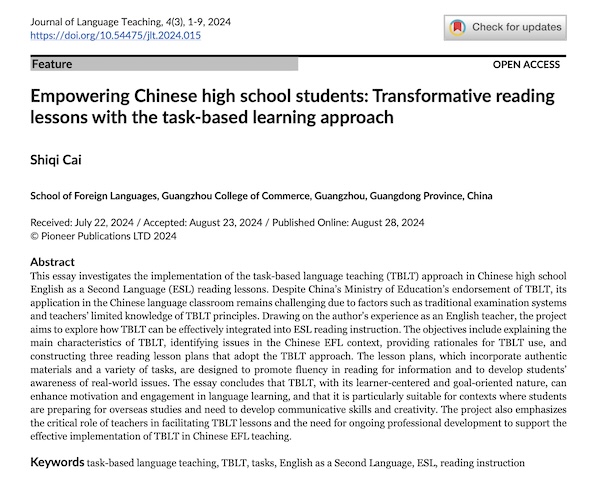Empowering Chinese high school students: Transformative reading lessons with the task-based learning approach
DOI:
https://doi.org/10.54475/jlt.2024.015Keywords:
task-based language teaching, TBLT, tasks, English as a Second Language, ESL, reading instructionAbstract
This essay investigates the implementation of the task-based language teaching (TBLT) approach in Chinese high school English as a Second Language (ESL) reading lessons. Despite China’s Ministry of Education’s endorsement of TBLT, its application in the Chinese language classroom remains challenging due to factors such as traditional examination systems and teachers’ limited knowledge of TBLT principles. Drawing on the author’s experience as an English teacher, the project aims to explore how TBLT can be effectively integrated into ESL reading instruction. The objectives include explaining the main characteristics of TBLT, identifying issues in the Chinese EFL context, providing rationales for TBLT use, and constructing three reading lesson plans that adopt the TBLT approach. The lesson plans, which incorporate authentic materials and a variety of tasks, are designed to promote fluency in reading for information and to develop students’ awareness of real-world issues. The essay concludes that TBLT, with its learner-centered and goal-oriented nature, can enhance motivation and engagement in language learning, and that it is particularly suitable for contexts where students are preparing for overseas studies and need to develop communicative skills and creativity. The project also emphasizes the critical role of teachers in facilitating TBLT lessons and the need for ongoing professional development to support the effective implementation of TBLT in Chinese EFL teaching.
References
Alderson, J. (2000). Assessing reading. Cambridge University Press. DOI: https://doi.org/10.1017/CBO9780511732935
Deng, C., & Carless, D. (2009). The communicativeness of activities in a task-based innovation in Guangdong, China. Asian Journal of English Language Teaching, 19, 113–134.
Ellis, R. (2003a). Designing a task-based syllabus. RELC Journal, 34(1), 64–81. https://doi.org/10.1177/003368820303400105 DOI: https://doi.org/10.1177/003368820303400105
Ellis, R. (2003b). Task-based language learning and teaching. Oxford University Press.
Ellis, R. (2013). Task-based language teaching: responding to the critics. University of Sydney Papers in TESOL, 8, 1-27.
Grabe, W., & Stoller, F. (2019). Teaching and researching reading (3rd ed.). Routledge. DOI: https://doi.org/10.4324/9781315726274-2
Kung, F. (2019). Teaching second language reading comprehension: the effects of classroom materials and reading strategy use. Innovation in Language Learning and Teaching, 13(1), 93–104. https://doi.org/10.1080/17501229.2017.1364252 DOI: https://doi.org/10.1080/17501229.2017.1364252
Lai, C. (2015). Task-based language teaching in the Asian context: where are we now and where are we going? In M. Thomas and H. Reinders. (Eds.), Contemporary task-based language teaching in Asia, (pp. 12–29). Bloomsbury Academic.
Leaver, B., & Willis, J. (2004). Task-based instruction in foreign language education: practices and programs. Georgetown University Press.
Littlewood, W. (2007). Communicative and task-based language teaching in East Asian classrooms. Language Teaching, 40(3), 243-249. https://doi.org/10.1017/S0261444807004363 DOI: https://doi.org/10.1017/S0261444807004363
Liu, Y., Mishan, F., & Chambers, A. (2021). Investigating EFL teachers’ perceptions of task-based language teaching in higher education in China. Language Learning Journal, 49(2), 131–146. https://doi.org/10.1080/09571736.2018.1465110 DOI: https://doi.org/10.1080/09571736.2018.1465110
Long, M. H. (1985). A role for instruction in second language acquisition: task-based language teaching. In Hyltenstam, K. & Pienemann, M. (Eds.), Modelling and assessing second language development (pp. 77-99). Multilingual Matters.
Long, M. (2000). Focus on form in task-based language teaching. In Lambert, R., Lambert, R., Shohamy, E., & Walton, A. (Eds.), Language policy and pedagogy: essays in honor of A. Ronald Walton (pp. 179-192). John Benjamin. DOI: https://doi.org/10.1075/z.96.11lon
Macalister, J. (2014). Teaching reading: Research into practice. Language Teaching, 47(3), 387-397. https://doi.org/10.1017/S026144481400007X DOI: https://doi.org/10.1017/S026144481400007X
Meguro, Y. (2019). Textual enhancement, grammar learning, reading comprehension, and tag questions. Language Teaching Research, 23(1), 58–77. https://doi.org/10.1177/1362168817714277 DOI: https://doi.org/10.1177/1362168817714277
Ministry of Education of China (MOE). (2001). National English curriculum standards for nine- year compulsory education and senior higher school education. People’s Education.
Nation, P. (2007). The four strands. Innovation in Language Learning and Teaching, 1(1), 2–13. https://doi.org/10.2167/illt039.0 DOI: https://doi.org/10.2167/illt039.0
Nation, P. (2014). Developing fluency. In Muller, T., Adamson, J. S. A., Brown, P. S., & Herder, S. (Eds.), Exploring EFL fluency in Asia (pp. 11–25). Palgrave Macmillan. https://doi.org/10.1057/9781137449405_2 DOI: https://doi.org/10.1057/9781137449405_2
Richards, J. (2015). Key issues in language teaching. Cambridge University Press. DOI: https://doi.org/10.1017/9781009024600
Samuda, V., & Bygate, M. (2008). Tasks in second language learning. Palgrave Macmillan. DOI: https://doi.org/10.1057/9780230596429
Skehan. P. (1996). A framework for the implementation of task-based instruction. Applied Linguistics, 17(1), 38-62. https://doi.org/10.1093/applin/17.1.38 DOI: https://doi.org/10.1093/applin/17.1.38
Skehan, P. (2003). Task-based instruction. Language Teaching, 36(1), 1–14. https://doi.org/10.1017/S026144480200188X DOI: https://doi.org/10.1017/S026144480200188X
Van den Branden, K. (2016). The role of teachers in task-based language education. Annual Review of Applied Linguistics, 36, 164–181. https://doi.org/10.1017/S0267190515000070 DOI: https://doi.org/10.1017/S0267190515000070
Vygotsky, L. (1978). Mind in society: the development of higher psychological processes. Harvard University Press.
Watkins, P. (2017). Teaching and developing reading skills: Cambridge handbooks for language teachers. Cambridge University Press. DOI: https://doi.org/10.1017/9781009024716
Willis, D., & Willis, J. (2007). Doing task-based teaching. Oxford University Press.
Willis, J. (1996). A framework for task-based learning. Longman.
Zheng, X., & Borg, S. (2014). Task-based learning and teaching in China: Secondary school teachers’ beliefs and practices. Language Teaching Research, 18(2), 205–221. https://doi.org/10.1177/1362168813505941 DOI: https://doi.org/10.1177/1362168813505941

Downloads
Published
Issue
Section
License
Copyright (c) 2024 Journal of Language Teaching

This work is licensed under a Creative Commons Attribution 4.0 International License.




